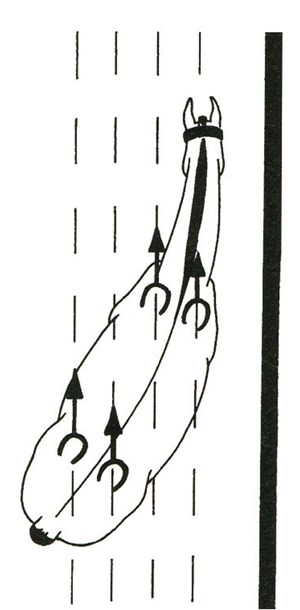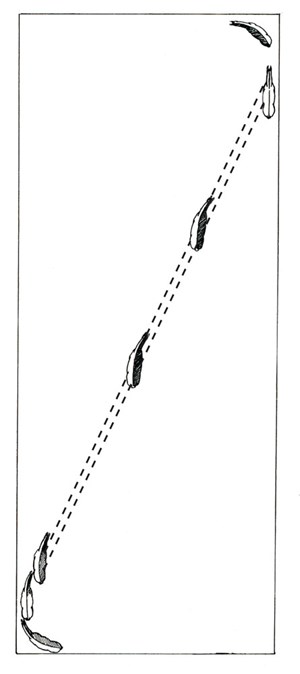The travers (haunches-in) is the first movement we teach a horse in which he bends in the direction of the line of travel. Learning travers is a prelude to teaching half pass, which requires quite a lot of lateral suppleness and cadence. These movements are the only two in dressage where the forehand is on the line of travel with the haunches displaced.
I was always taught that half pass was really travers on a diagonal line. In the past, travers was defined as a three-track movement, however, if you stand at C and watch a three-track travers on the diagonal, it looks like the haunches are badly trailing.
Within the past rule-change cycle, the Fédération Equestre Internationale (FEI), the international governing body for equestrian sport, and the U.S. Equestrian Federation (USEF), our national organization, changed the definition. Now travers is to be ridden as a four-track movement at approximately a 35-degree angle. (Remember shoulder-in is ridden on three tracks with approximately a 30-degree angle.) To me, this makes much more sense as the horse’s body in travers (and consequently the half pass) should have more bend than it does in a shoulder-in.
Judging Travers and Half Pass
When you judge the travers, keep these points in mind:
- Willingness. Is the horse willing to displace his haunches? To me the willingness is more important than a four-track angle with resistance and lack
of a quality trot. - Consistency of angle. Does the angle vary? At Second Level, it can happen. Perhaps it does not deserve an 8 or above, but again willingness and training going in the right way are important.
- Rider position. Is the rider’s position making it impossible for the horse to succeed? If so, then I will lower the rider-effectiveness score in the Collective Marks.
When you judge the half pass, keep in mind these questions:
- Preparation. Does the rider clearly prepare and start with the shoulders leading? Or do they come down centerline and start going sideways as soon as the front legs hit centerline? Haunches leading can rarely score more than 6.
- Accuracy. Does the rider start and end at the correct location? Remember judges, ending early does not give the rider extra credit. The point is that the rider has control of the lateral movement as well as the forward impulsion and cadence.
- Rider position. Is the riding correctly influencing the horse or not? We judges now have a score for that.
- Cadence and submission to the bend are of utmost importance. The well-executed half pass has lateral reach and elevation of the shoulders as well as a correct cadence and uphill balance.
Riding Travers and Half Pass
Travers. The most common mistake I see is a rider who does not keep the horse’s forehand moving straight down the track. Riders often turn the horse’s shoulders toward the rail, struggling to displace the hindquarters. They also twist their upper bodies, sitting to the outside in an attempt to create more displacement of the haunches with the outside leg.

I feel it is best to teach this exercise in walk. Think about coming straight out of the corner first. Keep the forehand walking straight down the track (the front legs do not cross) with a slight bend in the neck to the inside. Then shift your weight to the inside and move your outside leg slightly behind the girth.
Be aware of and avoid moving your hips to the outside. Don’t put your outside leg too far back either. The horse should be quite sensitive to the outside leg and should move the hindquarters quickly to the inside. If you do not have this reaction, you must go back and get the horse more sensitive to your outside leg aid. Without it, he will never succeed in travers or half pass.
Start with only a few strides as it is quite difficult for the horse to stay forward and supple. When he slows down too much or gets a bit stiff, straighten or walk a 10-meter circle and ask for a few more strides. Reinforce your inside leg as the “go forward” leg. Try not to use both legs actively at the same time. Think about which leg your horse needs to react to more quickly.
Think of this as a stretching exercise, much as you would do if you wanted to touch your toes. You would not succeed the first day. However, you would need to stretch several times a day, every day to succeed. It is always a good idea to go back to the more simple the head-to-the-wall leg-yield exercise, if you have difficulty getting the haunches
to react enough.
Remember, in the finished product, your horse’s shoulders and your shoulders are perpendicular to the long side and your outside hip is slightly back with weight in the direction of the bend. A correct rider position will create a lot of stretch through the outside of your body, too.
The finished movement will have the rider using the outside leg to displace the haunches and then the inside leg to ride the horse forward and create cadence. Don’t drive the horse with your outside leg for the entire movement. This will cause many problems in the half pass.
Half pass. The half pass should be moving forward and sideways with the rider always in control of the line of travel. Practice riding different angles so you can test the horse and see if you can go more sideways or if you can go on a longer angle and more forward. Do not let the horse take control because he will learn to fall sideways, usually with the haunches leading, and you will never develop cadence.

For the rider’s position, half pass is a bit easier, and the shoulders and hips will sit in the same position. For me, the most simple explanation about the rider’s position is to think about starting in a shoulder-in (putting the horse’s forehand on the line of travel or pointing the shoulders to the letter where you want to arrive) and then putting your weight to the inside and bringing the horse over with your weight and the outside leg. Always remember the shoulders must lead in the finished product.
A good exercise to test your horse is to start straight on the diagonal line. Then ride a few strides of a three-track travers. Over X, ride a four-track travers. Go back to three tracks and then straight before the corner. I don’t even mind in this exercise if you push the haunches ahead a few strides just to test the reaction to your outside leg. Just remember that in the final product you want to have control of the haunches and the angle in order to produce more cadence.
Personally, I am not a big fan of working a lot of travers on the long side. I feel it can put the horse onto his shoulders quite easily. I prefer to use the half pass or the travers on the circle to make my point. Also remember that the goal is increased lateral suppleness and reach through the shoulders, and therefore, more cadence and expression in trot and canter. If the rider pushes the haunches ahead in the half pass, the result will be the loss of cadence and the benefit of the movement will be lost.
Janet Foy is an FEI 4* and USEF “S” dressage judge and an “R” sport horse breed judge. A member of the USEF international High Performance Dressage Committee, she also teaches judges’ training programs nationwide. Author of the book Dressage for the Not-So-Perfect Horse, she is based in Colorado Springs, Colorado.











